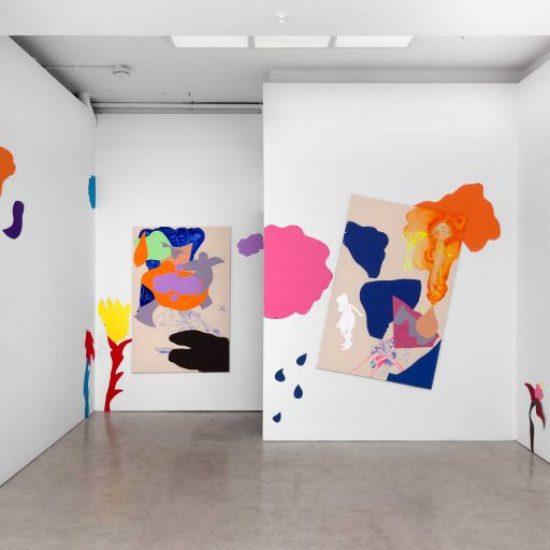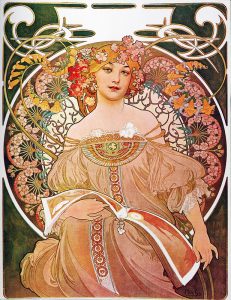A few animals, many flowers, a yellow hand and a blue one jump from one canvas to another, as if running along the walls. The characters in Alice Visentin’s paintings barely touch reality, clinging to a radical dimension of storytelling. amanti fabula, her first solo exhibition in London, realized in collaboration with Almanac and hosted by Sundy, is a declaration of love for the concept of making space.
Colorful cutouts of flowers sprout from all corners of the gallery. In the flower called nowhere (2024), a portrait of a child in bright orange bursts from the canvas and stains the whitewashed backdrop, while in the large Chris Ofili and friends (2024), an orange bird perched in a blue tree peers through some figures while a cat leaps toward a dancing lady and a mask, kindly smiling back. I remembered seeing this very painting the first time I met Visentin, in her studio at Gasworks, London, where she was in residence. It was leaning against a wall on which she was projecting, with the help of a magic lantern, a selection of images she had painted on film. The act of “quoting” Ofili, she told me, had helped open up her practice to a narrative dimension in which different subjects, times, and feelings coexist.
At that time, I was reading Jackie Wang’s Alien Daughters Walk into the Sun: An Almanac of Extreme Girlhood (2023), and a passage seemed made for the occasion: “The first time I caught myself thinking in the future anterior, or future perfect, I was startled by the peculiar temporal structure of the tense: what will have been, the space of the ‘imaginary real.’ It is the grammar of willed prophecy. The fact that this position is imaginatively accessible to me . . . is proof that something inside me has changed. I don’t want to say anything about ‘healing,’ but I have read that the future perfect is the language of healing. I kept catching myself saying it, that writing will have saved me, and with that it was decided—I will not be broken forever.”1 Temporalizing ourselves in the next future doesn’t mean capitalizing on the result, or competing with ourselves, but recovering the time-space of the present and laying it out like a long carpet. I’m pretty sure we talked about this, and that Visentin insisted on the importance of that space between us and what’s next. In order to create it, she sets off an archiving practice of the present, one that has no direction besides that provided by her imagination. For example, the same cat appearing in Among friends (2024) and Chris Ofili and friends acts as a multiple, reproducing itself in each painting through a completely different perspective and context, amplifying the nonlinearity of the narrative flow.
During her months at Gasworks, the artist delved into the collections of the Bishopsgate Institute and the MayDay Rooms, which preserve most of the documents of the feminist campaign “Wages for Housework” launched in the 1970s by Silvia Federici and Mariarosa Dalla Costa in Padua and New York. Issues such as work, childhood, and care hence became intertwined with her practice, in terms of a freer DIY aesthetic and as reflections on how feminism, like the fairy tale, uses metaphorical structures to create a fabulation capable of producing subjectivity. As the daughter of a nursery-school teacher, Visentin readily conceives of play as a space of the possible in which to produce Wang’s “imaginary-real.”
The smallest painting in the exhibition, Carne, carne (Meat, meat, 2024), is framed by a blue paper sheet recalling the sunny skies of childhood. It portrays a woman whose face covers almost the entire surface of the canvas, and in which a tree becomes a nose while an explosion of lights pierces through her long eyelashes, as if channeling a galactic expansion of her inner world. It is a world in which I imagine all the creatures that inhabit amanti fabula could live, after stripping themselves from these paintings, seeking new stories to embody.
at Sundy, London
until June 22, 2024
Alice Visentin (b. 1993, Castellamonte) lives and works in Turin. Visentin graduated from the Accademia Albertina di Belle Arti in Turin in 2018. Visentin has presented solo exhibitions in Italy and abroad, including amanti fabula, presented by Sundy and Almanac, London(2024); The morning tide of moods, Lateral, Rome (2023); Malefate, Almanac Project, Turin (2021); Planète, IIC, Paris (2021); and Prima Persona Singolare, Tile Project Space, Milan (2017). Recent group exhibitions include Cosmos. The Volcano Lover, Villa Olmo (2023); Sensing Painting, Castello di Rivoli Museo d’Arte Contemporanea, Turin (2023); Pittura Italiana, Triennale Milano, Milan (2023); Diario notturno, MAXXI L’Aquila (2022); ESPRESSIONI CON FRAZIONI, curated by Carolyn Christov-Bakargiev, Marcella Beccaria, Marianna Vecellio, Castello di Rivoli (2022); LXII Premio Termoli, Museo MACTE, Termoli (2021); and Artagon, Cité Internationale des Arts, Paris (2018). Visentin received a Visual Arts Fellowship at the American Academy in Rome for the year 2023, and in 2024 she was a fellow at Gasworks, London, supported by the Fondazione Memmo.
Leonardo Bentini is a writer based between London and Milan. He is a contributor for Flash Art and NERO; he has collaborated with Archive Books.




